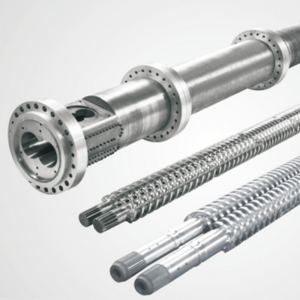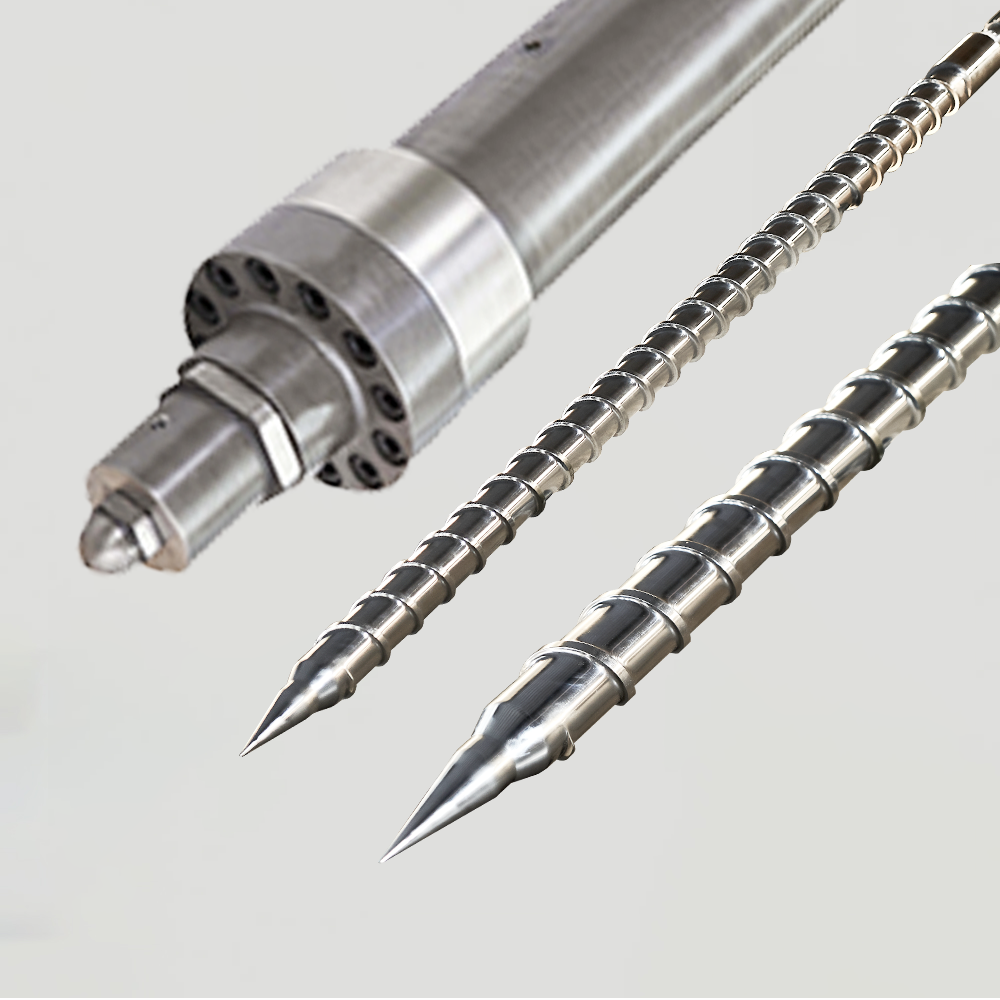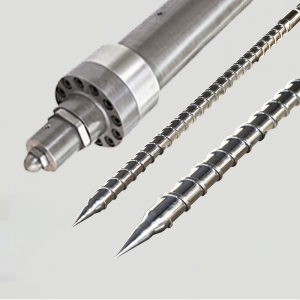
The Plastic Injection molding screw barrel stands at the heart of every injection molding machine. This tool tackles mixing challenges by blending plastics for top product quality. Whether someone uses a Blowing Screw Barrel, Plastic Machine Screw Barrel, or even a Twin Plastic Screw Barrel, they see better color and consistent results.
Common Mixing Challenges in Plastic Injection Molding Screw Barrel Applications

Inconsistent Color and Additive Distribution
Many manufacturers struggle with color streaks, swirling patterns, or cloudy spots in their molded parts. These issues often come from uneven mixing of colorants or additives. When the Plastic Injection molding screw barrel does not blend materials well, the result can be visible defects and weak spots in the product.
- Moisture in the resin can cause bubbles, splay marks, and streaks.
- Poor dispersion of pigments leads to inconsistent color and reduced strength.
- Equipment that is not calibrated properly can make these problems worse.
- Using too much or too little pigment also affects color quality.
Tip: Regular maintenance and using high-quality masterbatch can help keep colors consistent and reduce rejection rates.
Material Homogeneity Issues
Homogeneity means every part of the melted plastic is the same. If the screw design or temperature settings are off, the plastic may not mix evenly. This can cause some areas to be too soft, too hard, or even unmelted.
- The screw profile must match the type of plastic and any fillers used.
- Temperature zones in the barrel need careful control to avoid cold spots or overheating.
- Process settings like screw speed and back pressure also play a big role.
When the melt is not uniform, the final product may have weak points or fail quality checks.
Contamination and Degradation Concerns
Contamination and material breakdown can ruin a batch of plastic parts. Even small amounts of foreign material or degraded plastic can cause big problems.
Here’s a quick look at how contamination and degradation affect molded plastics:
| Issue | Effect on Product Quality | Visual Signs |
|---|---|---|
| Surface Delamination | Weak layers, peeling, or flaking | Peeling or flaking on the surface |
| Discoloration | Color streaks, abnormal patches, reduced strength | Streaks or odd color spots |
| Splay Marks | Brittle parts, poor impact resistance, surface marks | Silvery or cloudy streaks |
Regular cleaning, proper drying, and using the right screw barrel design help prevent these problems. Keeping the process clean and well-controlled leads to stronger, more reliable products.
How Plastic Injection Molding Screw Barrel Design Solves Mixing Problems

Influence of Screw Geometry and Mixing Sections
Screw geometry plays a huge role in how well plastics mix inside the barrel. The shape, length, and pitch of the screw determine how plastic pellets move, melt, and blend. When engineers design the screw with the right width-to-length ratio and add special mixing sections, they help the material flow smoothly and melt evenly. This steady flow is key for getting a uniform color and texture in the final product.
General-purpose screws sometimes leave behind unmelted bits or create dead zones where material sits too long. These spots can cause color streaks or weak parts. Advanced screw designs, like those with spiral blades, keep the plastic moving in a loop. The granules rise from the bottom, fall down the sides, and repeat this cycle. This action mixes the plastic so well that over 95% of the material blends evenly in just a few minutes. The mixing section also helps spread out additives and colorants, stopping them from clumping or separating. When the mixing section works right, every part of the melted plastic looks and performs the same.
Note: Custom screw designs tailored to specific plastics and applications can boost mixing performance and even cut down on cycle times.
Benefits of Barrier and Maddock Screw Designs
Barrier and Maddock screw designs take mixing to the next level. Barrier screws use a second flight to split the melted plastic from the solid granules. This separation lets the plastic melt faster and more evenly. The design also prevents unmelted bits from clogging the screw, which means fewer defects and better color consistency. Barrier screws can handle higher speeds without breaking up the solid bed, so they work well for both fast and high-output jobs.
Here are some key benefits of barrier screw designs:
- Better melt uniformity and improved dispersion of additives
- Faster cycle times and less downtime
- Lower material waste thanks to consistent molding
- Reduced energy use because of efficient melting
- Longer equipment life with less wear and maintenance
Maddock mixers focus on dispersive mixing. They break up solid chunks and gels, making sure the melt is smooth and free of lumps. By adjusting the number and size of channels, Maddock screws can lower the pressure and temperature inside the barrel. This helps prevent resin from burning or degrading. Compared to standard screws, Maddock mixers shorten the time plastic spends in the barrel, which means less chance for defects and faster production.
Material Selection and Surface Treatments for Enhanced Mixing
The materials used to make the screw and barrel matter just as much as the design. High-quality steels like 38CrMoAlA, H13, and bimetallic alloys stand up to the heat, pressure, and wear of daily use. Some screws get special coatings, such as nitriding or carbide layers, to make them even tougher. These treatments help the screw last longer and keep mixing performance steady.
| Material | Key Features | Surface Treatment Options |
|---|---|---|
| 38CrMoAlA | High strength, wear resistance | Nitriding, bimetallic coating |
| H13 Steel | Good for high temperatures, durable | Nitriding, chrome plating |
| D2 Tool Steel | Abrasion resistance, moderate corrosion | Carbide coating, hard facing |
| Bimetallic Alloy | Extreme wear and corrosion resistance | Ceramic or tungsten carbide coating |
Surface treatments do more than just protect the screw. Smooth, hard coatings like ceramic chrome fill in tiny cracks and pores. This makes it harder for plastic to stick or burn, which keeps the melt clean and uniform. These coatings also help the screw clean itself during material changes, cutting down on downtime and contamination. For products that need high purity, such as medical parts, these treatments make a big difference in quality.
Tip: Choosing the right material and surface treatment for the Plastic Injection molding screw barrel can prevent black specks, reduce scrap, and keep production running smoothly.
Real-World Results from Optimized Plastic Injection Molding Screw Barrels
Case Study: Achieving Superior Color Consistency
Many manufacturers want perfect color in every plastic part. One company decided to upgrade their Plastic Injection molding screw barrel to solve color streaking and uneven shades. They made several changes:
- They optimized the screw geometry to improve how the plastic melted and mixed.
- They used nitrided steel barrels for better wear resistance and stable temperatures.
- They kept barrel temperatures between 160–180 °C for steady melt flow.
- They adjusted screw speed to control the flow and keep the product size consistent.
These upgrades stopped uneven mixing and color problems. The results speak for themselves:
| Metric | Screw Configuration | Value | Improvement / Note |
|---|---|---|---|
| Time-averaged mixing efficiency | FSES_1 | 0.09 | Baseline with FSE element only |
| Time-averaged mixing efficiency | FSES_2 (with pins) | 0.11 | 22.2% increase compared to FSES_1 |
| Segregation scale (uniformity indicator) | FSES_2 | Lowest among tested screws | Indicates best mixing uniformity, improved by pins |
| Segregation scale | STDS_1 | Highest | Worst uniformity, baseline standard screw |
With these changes, the company saw fewer defects and much better color uniformity. They also noticed less waste and more stable production.
Case Study: Minimizing Contamination and Improving Homogeneity
Another factory faced problems with contamination and uneven mixing. They focused on equipment maintenance and process upgrades. By replacing worn parts and using modular screw designs, they reduced the risk of contamination. Smart sensors helped them monitor temperature and screw speed in real time. Advanced temperature controls stopped the plastic from burning or breaking down.
Manufacturers reported several benefits:
- Fewer defects and more consistent products.
- Up to 30% lower scrap rates after upgrading screw and barrel systems.
- 10–20% higher output and longer times between maintenance.
- Big cost savings from less waste and downtime.
General Motors even saved $20 million a year by improving process stability and product quality. These results show that optimizing the screw barrel can make a huge difference in both quality and cost.
The Plastic Injection molding screw barrel helps manufacturers achieve consistent, high-quality products. They can boost mixing efficiency by following these steps:
- Regularly assess screw barrel condition and upgrade when needed.
- Choose wear-resistant materials and maintain proper lubrication.
- Train operators and monitor performance for lasting results.
FAQ
How often should manufacturers replace a screw barrel?
Most manufacturers check screw barrels every 12–18 months. They replace them when they see wear, mixing issues, or drops in product quality.
What signs show a screw barrel needs maintenance?
Look for color streaks, unmelted plastic, or odd noises. These signs mean the screw barrel may need cleaning or repair.
Can a screw barrel handle different types of plastic?
Yes, many screw barrels work with various plastics. For best results, manufacturers choose a screw design that matches the material and application.
Tip: Always follow the machine’s manual for maintenance and material changes.
Post time: Aug-06-2025
